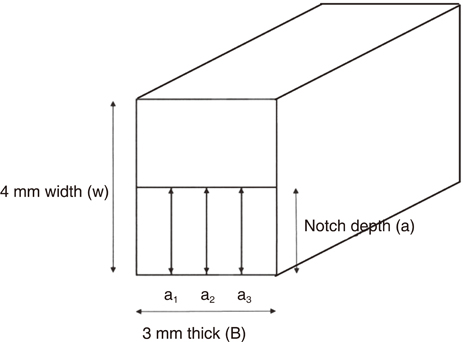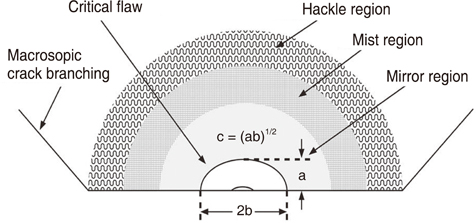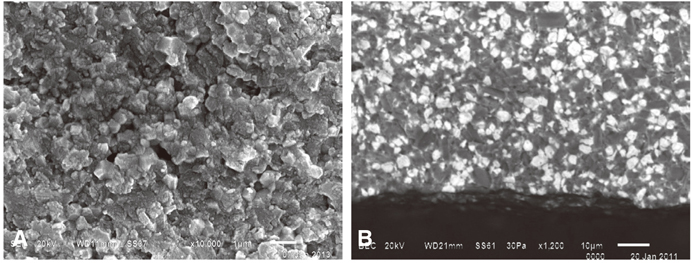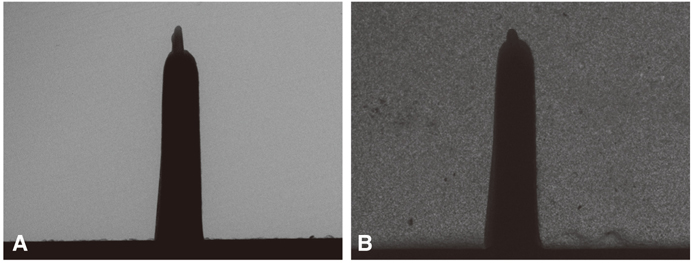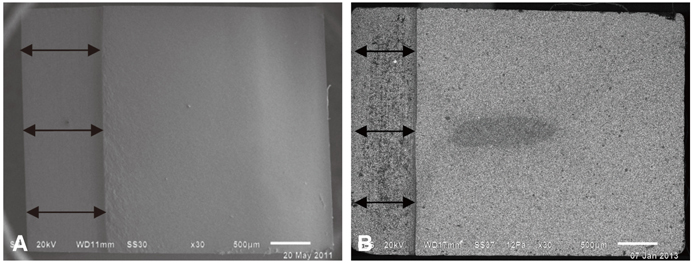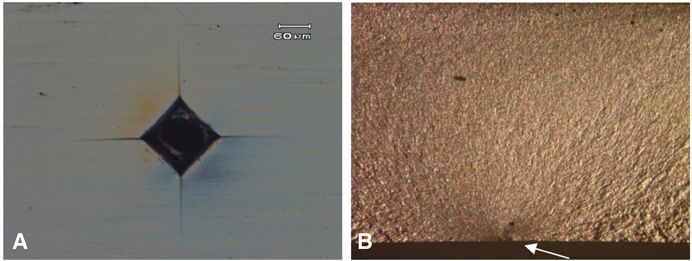J Adv Prosthodont.
2013 Feb;5(1):36-43. 10.4047/jap.2013.5.1.36.
Comparison of two fracture toughness testing methods using a glass-infiltrated and a zirconia dental ceramic
- Affiliations
-
- 1Department of Prosthodontics, Faculty of Dentistry, Mahidol University, Bangkok, Thailand. kallaya.sup@mahidol.ac.th
- KMID: 2284770
- DOI: http://doi.org/10.4047/jap.2013.5.1.36
Abstract
- PURPOSE
The objective of this study was to compare the fracture toughness (KIc) obtained from the single edge V-notched beam (SEVNB) and the fractographic analysis (FTA) of a glass-infiltrated and a zirconia ceramic.
MATERIALS AND METHODS
For each material, ten bar-shaped specimens were prepared for the SEVNB method (3 mm x 4 mm x 25 mm) and the FTA method (2 mm x 4 mm x 25 mm). The starter V-notch was prepared as the fracture initiating flaw for the SEVNB method. A Vickers indentation load of 49 N was used to create a controlled surface flaw on each FTA specimen. All specimens were loaded to fracture using a universal testing machine at a crosshead speed of 0.5-1 mm/min. The independent-samples t-test was used for the statistical analysis of the KIc values at alpha=0.05.
RESULTS
The mean KIc of zirconia ceramic obtained from SEVNB method (5.4 +/- 1.6 MPa.m1/2) was comparable to that obtained from FTA method (6.3 +/- 1.6 MPa.m1/2). The mean KIc of glass-infiltrated ceramic obtained from SEVNB method (4.1 +/- 0.6 MPa.m1/2) was significantly lower than that obtained from FTA method (5.1 +/- 0.7 MPa.m1/2).
CONCLUSION
The mean KIc of the glass-infiltrated and zirconia ceramics obtained from the SEVNB method were lower than those obtained from FTA method even they were not significantly different for the zirconia material. The differences in the KIc values could be a result of the differences in the characteristics of fracture initiating flaws of these two methods.
Keyword
Figure
Reference
-
1. Conrad HJ, Seong WJ, Pesun IJ. Current ceramic materials and systems with clinical recommendations: a systematic review. J Prosthet Dent. 2007. 98:389–404.2. Kelly JR, Tesk JA, Sorensen JA. Failure of all-ceramic fixed partial dentures in vitro and in vivo: analysis and modeling. J Dent Res. 1995. 74:1253–1258.3. Scherrer SS, Denry IL, Wiskott HW. Comparison of three fracture toughness testing techniques using a dental glass and a dental ceramic. Dent Mater. 1998. 14:246–255.4. Piconi C, Maccauro G. Zirconia as a ceramic biomaterial. Biomaterials. 1999. 20:1–25.5. Yilmaz H, Aydin C, Gul BE. Flexural strength and fracture toughness of dental core ceramics. J Prosthet Dent. 2007. 98:120–128.6. Guazzato M, Albakry M, Swain MV, Ironside J. Mechanical properties of In-Ceram Alumina and In-Ceram Zirconia. Int J Prosthodont. 2002. 15:339–346.7. Triwatana P, Nagaviroj N, Tulapornchai C. Clinical performance and failures of zirconia-based fixed partial dentures: a review literature. J Adv Prosthodont. 2012. 4:76–83.8. Quinn JB, Sundar V, Lloyd IK. Influence of microstructure and chemistry on the fracture toughness of dental ceramics. Dent Mater. 2003. 19:603–611.9. Fischer H, Waindich A, Telle R. Influence of preparation of ceramic SEVNB specimens on fracture toughness testing results. Dent Mater. 2008. 24:618–622.10. Gogotsi GA. Fracture toughness of ceramics and ceramic composites. Ceram Int. 2003. 29:777–784.11. Morrell R. Fracture toughness testing for advanced technical ceramics: internationally agreed good practice. Adv Appl Ceram. 2006. 105:88–98.12. International organization for standardization. ISO/FDIS 6872 Dentistry - Ceramic materials. 2007. Switzerland:13. Kübler JJ. Fracture toughness of ceramics using the SEVNB method; Round-Robin. VAMAS Report No. 37. 1999. Switzerland: EMPA, Swiss Federal Laboratories for Materials Testing and Research, Dübendorf.14. Kübler JJ. Salem JA, Quinn GD, Jenkins MG, editors. Fracture toughness of ceramics using the SEVNB method: from a preliminary study to a standard test method. Fracture resistance testing of monolithic and composite brittle materials: STP 1409. 2002. Pennsylvania: ASTM;93–106.15. Scherrer SS, Kelly JR, Quinn GD, Xu K. Fracture toughness (KIc) of a dental porcelain determined by fractographic analysis. Dent Mater. 1999. 15:342–348.16. Mecholsky JJ Jr. Fractography: determining the sites of fracture initiation. Dent Mater. 1995. 11:113–116.17. Taskonak B, Mecholsky JJ Jr, Anusavice KJ. Fracture surface analysis of clinically failed fixed partial dentures. J Dent Res. 2006. 85:277–281.18. Oh WS, Park JM, Anusavice K. Fracture toughness (KIC) of a hot-pressed core ceramic based on fractographic analysis of fractured ceramic FPDs. Int J Prosthodont. 2003. 16:135–140.19. Scherrer SS, Quinn JB, Quinn GD, Kelly JR. Failure analysis of ceramic clinical cases using qualitative fractography. Int J Prosthodont. 2006. 19:185–192.20. ASTM, C1322-05a. Standard practice for fractography and characterization of fracture origins in advanced ceramics. 2005. Pennsylvania: American Society for Testing and Materials.21. Irwin GR. Crack-extension force for a part-through crack in a plate. J Appl Mech. 1962. 29:651.22. Taskonak B, Yan J, Mecholsky JJ Jr, Sertgöz A, Koçak A. Fractographic analyses of zirconia-based fixed partial dentures. Dent Mater. 2008. 24:1077–1082.23. Scherrer SS, Quinn GD, Quinn JB. Fractographic failure analysis of a Procera AllCeram crown using stereo and scanning electron microscopy. Dent Mater. 2008. 24:1107–1113.24. Quinn JB, Quinn GD, Kelly JR, Scherrer SS. Fractographic analyses of three ceramic whole crown restoration failures. Dent Mater. 2005. 21:920–929.25. Scherrer SS, Quinn JB, Quinn GD, Wiskott HW. Fractographic ceramic failure analysis using the replica technique. Dent Mater. 2007. 23:1397–1404.26. Aboushelib MN, Feilzer AJ, Kleverlaan CJ. Bridging the gap between clinical failure and laboratory fracture strength tests using a fractographic approach. Dent Mater. 2009. 25:383–391.27. Thompson JY, Anusavice KJ, Naman A, Morris HF. Fracture surface characterization of clinically failed all-ceramic crowns. J Dent Res. 1994. 73:1824–1832.28. Wang H, Pallav P, Isgrò G, Feilzer AJ. Fracture toughness comparison of three test methods with four dental porcelains. Dent Mater. 2007. 23:905–910.29. Anstis GR, Chantikul P, Lawn BR, Marshall DB. A critical evaluation of indentation techniques for measuring fracture toughness: I, Direct crack measurements. J Am Ceram Soc. 1981. 64:533–538.30. Chantikul P, Anstis GR, Lawn BR, Marshall DB. A critical evaluation of indentation techniques for measuring toughness: II, Strength method. J Am Ceram Soc. 1981. 64:539–543.31. Munz D. Bradt RC, Evans AG, Hasselman DPH, Lange FF, editors. Effect of specimen type on the measured values of the fracture toughness of brittle ceramics. Fracture Mechanics Ceramics 6. 1983. New York-London: Plenum press;1–26.32. Quinn GD, Kübler JJ, Gettings RJ. Fracture toughness of advanced ceramics by the surface crack in flexure (SCF) method: a VAMAS round robin. VAMAS Report No. 17. 1994. Switzerland: EMPA-Dübendorf.33. Nishida T, Hanaki Y, Pezzotti G. Effect of notch-root radius on the fracture toughness of a fine-grained alumina. J Am Ceram Soc. 1994. 77:606–608.34. Damani RJ, Schuster C, Danzer R. Polished Notch modification of SENB-S Fracture Toughness Testing. J Eur Ceram Soc. 1997. 17:1685–1689.35. Fischer H, Marx R. Fracture toughness of dental ceramics: comparison of bending and indentation method. Dent Mater. 2002. 18:12–19.36. Kübler J. Fracture toughness of ceramics using the SEVNB method: preliminary results. Ceram Eng Sci Proc. 1997. 18:155–162.
- Full Text Links
- Actions
-
Cited
- CITED
-
- Close
- Share
- Similar articles
-
- A comparative study on the fracture behavior of zironia, glass infiltrated alumina and PFM full crown system
- Mechanical Properties and Microstructure of the Leucite-Reinforced Glass-Ceramics for Dental CAD/CAM
- Effect of glass-infiltration treatments on the shear bond strength between zirconia and ultra low-fusing porcelain veneer
- Effect of adhesive luting on the fracture resistance of zirconia compared to that of composite resin and lithium disilicate glass ceramic
- The physical properties of reused IPS empress ceramic part IV: Hardness and fracture toughness


